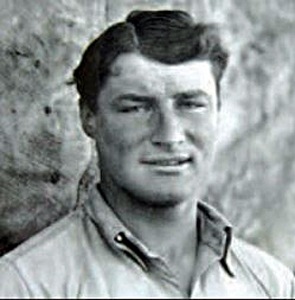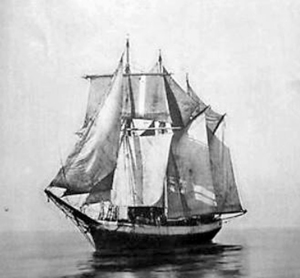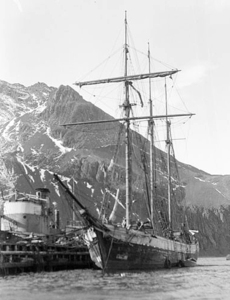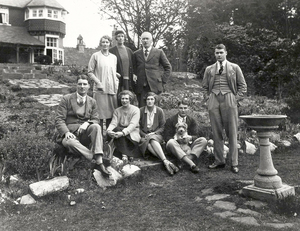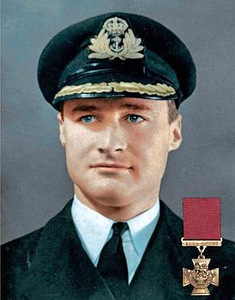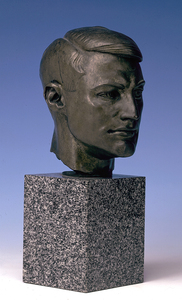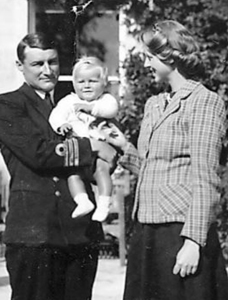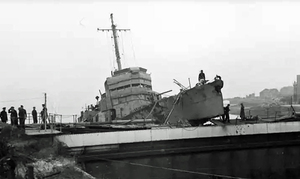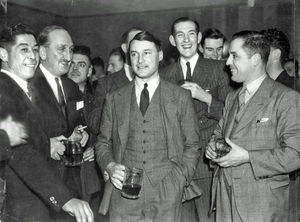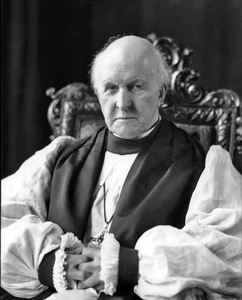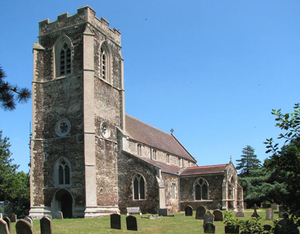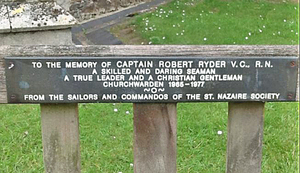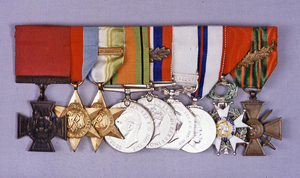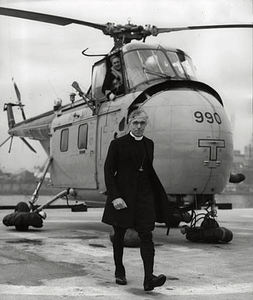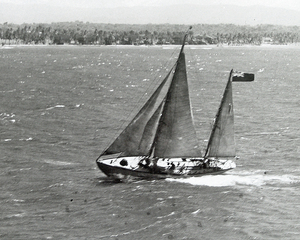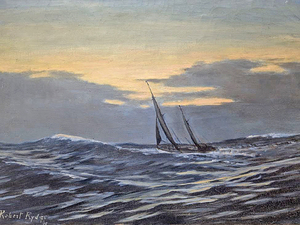RYDER, ROBERT (Red) EDWARD DUDLEY
1908-1986 from England
naval officer, recipient of the Victoria Cross, and sailing master, was born at Dehra Dun in Northern India on16 February 1908 to Colonel Charles Henry Dudley Ryder (b.1868 d.1945) CB, CIE, DSO, Surveyor General of India, and Ida Josephine Grigg (b.1872 m.1892 d.1948). He was a great-grandson of Henry Ryder (successively Bishop of Gloucester, from 1815, and Bishop of Lichfield and Coventry, from 1824) – who was the youngest son of Nathaniel Ryder, 1st Baron Harrowby. Charles Ryder was a a distinguished explorer, surveyor and cartographer..
Robert Ryder had two brothers; both were killed in World War II. Major Lisle Charles Dudley Ryder (Royal Norfolk Regiment) was murdered in the Le Paradis massacre of May 1940 in France – and Major Ernle Terrick Dudley Ryder (Gurkha Rifles) was lost at sea of the coast of Sumatra, in February 1942, after the fall of Singapore.
Ryder (known as ‘Red’ because of his initials) was educated at Hazelhurst School and Cheltenham College before entering the Royal Navy in 1926. He served as a midshipman in the battleship HMS Ramillies from 1927 to 1929. As a lieutenant he served in the submarine HMS Olympus as part of the 4th Flotilla in China from 1930 to 1933.(Ryder was responsible for navigating the submarine on her voyage from from England to Hong Kong between April-June 1931). Ryder also commanded several expeditions, which included captaining the ketch Tai-Mo-Shan on a 16,217-mile voyage from Hong Kong to Dartmouth, England during 1933–1934. On the voyage back to the UK, Ryder learnt that the Admiralty was looking for ‘a Lieutenant capable of commanding and navigating a 112 ft topsail schooner for a three-year voyage to the Antarctic.’ Ryder immediately applied for the job and he was appointed master of the Penola – the expedition ship of the British Graham Land Expedition (BGLE).
The British Graham Land expedition was a geophysical and exploration expedition to Graham Land in Antarctica between 1934 and 1937, under the leadership of John Rymill. The expedition used a combination of traditional and modern practices in Antarctic exploration, with both dog teams and motor sledges as well as a single-engine aircraft for exploration. This was largely a privately sponsored Antarctic expedition, operating on a very small budget. Surveying and exploration mapped 1000 miles of the Antarctic peninsula. The expedition became the benchmark for subsequent British scientific research in Antarctica – in the work of Operation TABARIN, the Falkland Islands Dependencies Survey (FIDS) and the British Antarctic Survey (BAS).
The BGLE expedition ship was an elderly three-masted sailing vessel christened the Penola, which had very unreliable auxiliary engines. Built in Brittany, France in 1908, the three masted topsail schooner (137 tons) was intended for the Icelandic cod fisheries and named Alcyon. She was later converted into a yacht and named Navaho. BGLE purchased the schooner for £2,750. In good windy conditions she could average four knots when under sail, and on the occasions when the engine was used (with a following gale) she could average nine knots. As a result of the Penola’s shortcomings, seamanship of the highest calibre was required. The leader and members of the BGLE soon realised that Robert Ryder was an exceptional seaman. In later life Ryder considered mastering the seamanship skills required by the Penola to have been his greatest achievement.
After establishing bases in the Antarctic, the Penola made several trips to the Falklands and to South Georgia during the southern winter months. The records of the expedition make it clear that the condition of the ship caused some disagreement between Robert Ryder and John Rymill. Ryder insisted that a major refit was required, but Rymill had no funds to cover the cost.
Penola left St. Katherine’s Dock, London, on 10 September 1934 and arrived in Stanley on 4 November 1934. Stores, equipment, and husky dogs, which had been previously sent down to the Falklands via Montevideo, were awaiting their arrival at the Government Jetty.
John Rymill writes:
HMS Exeter and RRS Discovery II were in port when Penola arrived, and both gave us valuable assistance, for which we were very grateful. With help of working parties from them we set about altering the rig of the Penola to one more suitable for working in the ice … We reduced the windage by sending down the yards and two of the topmasts … We shortened the bowsprit by sawing most of it off, only leaving enough to carry two headsails. These alterations very materially increased our efficiency as a motor ship, apart from reducing windage, it trimmed the ship more by the stern, giving the propellors a better grip and protection from the ice. While in Stanley both the engines were completely stripped down in an attempt to improve their reliability. The engineer’s report on the state of the engines was not encouraging. The bed on which the engines sat had been made of unseasoned wood, and they had warped and split badly, making the engines shift out of alignment and causing bad wear in the gearbox. Captain Nelson from the Discovery II also allowed us to take one his sailors, Duncan CARSE, who had joined in England … this was a great help, as we considered, after the experience of the voyage out [to the Falklands], that a ship’s party of six would be insufficient when handling the Penola unsupported by the shore party. With all the work on the engines and rigging, as well as being held up by financial troubles in England, we were not able to leave Stanley until New Year’s Eve. Throughout our stay in this wonderfully hospitable colony, we met with every possible kindness, especially from Mr George ROBERTS, the Director of Public Works, who did everything he could to help us.
But as soon as the ship was clear of the Falklands it ran into very stormy weather, and the engines again shifted. The Penola was forced to anchor at Port Harriet. The only solution was the drastic step of blocking the beds with reinforced concrete. The ship returned to Stanley and the necessary cement was purchased. Rymill and Ryder then decided that in order not to lose the coming open season on the Antarctic peninsula to disconnect the engines and to carry on under sail alone - (n.b the sails had been laid out and repaired in Stanley Town Hall) – the engines could be repaired during the following winter. Robert Ryder’s ship handling skills would then be tested in very difficult circumstances. The Penola sailed out of Stanley on 7 January 1935 – and the South Shetland Islands were sighted on 21 January 1935.
Once various expedition bases were established Ryder took part in numerous exploration and surveying trips. He made extensive and detailed maps and charts and was often found in the crow’s nest of the ship directing its passage through the ice.
Penola left the Antarctic peninsula for Stanley on 12 March 1936, arriving on 24 March 1936. Ryder decided that a major refit was necessary, but there were insufficient funds available.
Fortunately, the Vestfold Whaling Company in South Georgia offered assistance, including free use of the company’s floating dock. The repair facilities were located at Stromness Harbour, which was the major ship repair yard on South Georgia, operated by SALVESEN of Leith. During the period of the ship's refit Brian ROBERTS took the opportunity to conduct sea bird research on South Georgia.
Ryder recounts the journey and repairs thus:
We were somewhat short-handed for the trip … but we kept up a steady 80-90 miles a day…During the night of 15 March … the boom end of the mizzen fell off, leaving the boom swinging wild. It was not easy to stop … it took three days to get things ship-shape again. And rather indicated that we were too short handed for emergencies of this nature … At dusk we could smell the peat smoke from Stanley, 70 miles up wind of us, and at daybreak the following morning, 24 March, we rounded Cape Pembroke … the wind was dead ahead … we found our progress stopped … it took us three hours to enter Port William and Stanley Harbour.The friendliness of the Falkland Islanders impressed us all, and greatly added to joy of our arrival. Presents of such things as eggs, milk, vegetables, and flowers … were showered upon us, and the hospitality and kindness throughout our stay in Stanley helped to make the time pass all too quickly. The day after our arrival we shifted berth to alongside the Government jetty … here we could enjoy a feeling of entire security which we had not known for many months
On 3 August the Penola sailed for South Georgia, arriving at Stromness on 12 August. The whaling stations, especially Salvesen, provided a great deal of help during the refit – including the use of the floating dock. It was found that the propellers had worn completely though their shaft bearings. New bearings were manufactured in the workshops at Stromness. On 2 October the Penola sailed for the Falklands, arriving 31 October – a crossing of 30 days against prevailing winds. During their stay in the Falklands the crew took part in numerous Christmas activities, including a special horse race for the crew of the Penola. Ryder become acquainted with Jack FELTON and his family at Teal Inlet farm - especially with the daughter of the house - Eileen. He often stayed at the farm: 'They are a delightful family ... and I like them very much, particularly their daughter, who is a great sport.'
Penola stayed in Stanley until 29 December before leaving for reaching the South Shetland Islands on 17 January 1937.
Penola left for South Georgia on 14 March 1937, with the shore party embarked. The ship arrived at Grytviken on 2 April 1937. The next day Leganger HANSEN, Salvesen’s manager at Leith arranged to have the ship towed around to Stromness.
Rymill commented that:
We met with every possible kindness from the whalers, and on 17 April the shore party sailed for home in the Coronda II, a transport ship under the command of Captain Sinclair BEGG. Our passages given to us by Messrs. Salvesen, which was only part of the generosity shown to the expedition by that firm.
The Penola sailed for the UK in early May, arriving on 4 August 1937. She made the long passage almost entirely under sail. After a few days at Falmouth, the ship continued to her final destination – Portsmouth. Six weeks after her return the Penola was sold for £1,700.
Rorke Bryan, in his book Ordeal by ice: ships of the Antarctic comments: ‘Although Penola’s contribution was limited by engine problems and lethargic sailing, her performance in ice and unchartered rocky shores was excellent’. Rymill described her as’ an admirable seaboat’ professionalism of her sailing crew, especially Robert Ryder. Governor HENNIKER HEATON had been well aware of the problems that Ryder faced as the sailing master of the Penola - he later commented 'the wiseacres of the Falklands we quite satisfied that if the ship ever got south she would never return.'
On completion of the BGLE expedition Ryder returned to naval duties and when World War II started, he was serving as a lieutenant commander in HMS Warspite. In 1940, In 1940, he was promoted to be the captain of the Q-ship HMS Willamette Valley X39 (disguised as RFA Edgehill) which was sunk by a torpedo in the Atlantic, 200 miles west of Ireland; Ryder was adrift and alone for four days, without food or water, before rescue. He was promoted to commander of the frigate HMS Fleetwood and in 1941, he became the captain of the Prince Philippe which sank after a collision in the Firth of Clyde. Ryder, led the St. Nazaire Raid, codenamed ‘Operation Chariot’, on 28 March 1942. For his actions during this operation, he was one of five people awarded the Victoria Cross. Ryder took part in the Allied attack on the German-occupied port of Dieppe, on 19 August 1942. He was promoted Captain in 1948, and later served as naval attaché at Oslo.
Ryder married Constance Hilaré Myfanwy Green-Wilkinson on 26 April 1941 at St Pater's Church, Cranbourne. Hilaré's father (the Reverend Lumley Green-Wilkinson) was the Vicar of the parish of Ascot, and at one time had been the chaplain to the Archbishop of Canterbury. Robert and Hilaré were married by Cosmo Lang, the Archbishop of Canterbury
The Ryders had two children - Lisle (b 1943) who also joined the Royal Navy, before being ordained priest in the Church of England, and eventually becoming a Canon of Worcester Cathedral - and Susan (b 1944). who became a successful portraitist and painter. In 1981 she was commissioned by the Prince of Wales to paint Princess Diana in her wedding dress.
Following his retirement from the Royal Navy, Ryder stood for election to Parliament as the Conservative Party candidate for Merton and Morden at the 1950 general election. He was elected and served as a Member of Parliament for five years. From 1955 to 1959 Ryder was Managing Director John Lewis Partnership. In 1962 Ryder was appointed to the management committee of the Royal National Lifeboat Institution (RNLI). He served until 1974, thereafter becoming a Life Vice-President.
In 1964 the Ryders retired to live in the Old Rectory at Wolverton, on the Queen’s Sandringham estate, in Norfolk. They were regularly guests of the Royal Family, and Robert occasionally joined shooting parties on the estate. Ryder told his sister:
[It was] great fun really, but of course I am terribly out of practice, but it didn't seem to matter too much. Fortunately I didn't pepper Prince Charles or anything like that, and Prince Philip, Duke of EDINBURGH was warned I was a bad shot.
Shortly before the shooting party Robert and Hilaré Ryder had been invited to dinner at Sandringham:
I sat on the Queen's left, with the Queen Mother on the other side, so I had a Queen each side and Hilaré next to Prince Philip. All very alarming.
In 1977 the Ryders moved from Norfolk to Inkpen, near Newbury. Ryder’s wife Hilaré died on 19 September 1982. Robert Ryder died on 29 June 1986, while on the yacht Watchdog during a sailing trip to France. His funeral service service was held at St Michael's Church, Inkpen on 10 July 1986, and his ashes are buried at Headington Crematorium, Oxford. A memorial service was held at Holy Trinity Church, Prince Consort Road, South Kensington, on 2 October 1986. The address was given by the former bishop of Norwich, Launcelot Fleming - who said that Ryder was 'a supremely humble man, who had an enterprising and adventurous nature ... a man with a strong sense of duty ... resolution and great courage ... with straightforward integrity and honesty ... singlemindedness and utterly humble.'
Ryder was awarded the Victoria Cross on 19 May 1942. His other awards include: the Légion d'honneur, and the Croix de guerre. He was 'Mentioned in despatches' on three different occasions. In 1939 Ryder had been awarded the Polar Medal with clasp; he is the only recipient of the Polar medal to be also be awarded the Victoria Cross.
The official citation for the award of the Victoria Cross reads:
The KING has been graciously pleased to approve the award of the Victoria Cross for daring and valour in the attack on the German Naval Base at St. Nazaire. ‘For great gallantry in the attack on St Nazaire. He commanded a force of small, unprotected ships in an attack on a heavily defended port and led H.M.S. Campbeltown in under intense fire from short range weapons at point blank range. Though the main object of the expedition had been accomplished in the beaching of Campbeltown, he remained on the spot conducting operations, evacuating men from Campbeltown and dealing with strong points and close-range weapons while exposed to heavy fire for one hour and sixteen minutes, and did not withdraw till it was certain that his ship could be of no use in rescuing any of the Commando Troops who were still ashore. That his Motor Gun Boat, now full of dead and wounded, should have survived and should have been able to withdraw through an intense barrage of close-range fire was almost a miracle.’ (Ryder’s medal is now held by the Imperial War Museum).
Ryder was a talented amateur painter and a very modest and most reluctant hero. One biographer wrote that he was ‘brave almost beyond belief; he was as resolute as he was reserved and relentlessly self-effacing’. 'Ryder's Christian faith was one of the lynch-pins of his life ... simple, undemonstrative and firm'. He is remembered in a bench that sits outside the porch of St Peter’s church in Wolferton, where he was churchwarden for twelve years. The bench was donated by the St. Nazaire Society, and it bears the inscription:
To the memory of Captain Robert Ryder VC RN; a skilled and daring seaman; a true leader and a Christian Gentleman. Churchwarden 1965-1977.
Editorial comments:
1. Penola, the expedition ship of the BGLE, was named after the birthplace of John Rymill - Penola, in South Australia.
2. One of the members of the BGLE expedition was William Launcelot Scott Fleming (1908-1990), who was the chaplain and geologist. He was ordained priest in 1934. He was awarded the Polar Medal. In later life he became a chaplain in the Royal Naval Reserve during WW II, serving in HMS Queen Elizabeth. After WWII he became the Director of the Scott Polar Research Institute, in Cambridge. and subsequently the Bishop of Portsmouth, and then the Bishop of Norwich and finally the domestic chaplain to HM Queen and dean of St George's Windsor Castle. In 1967, unusually for a bishop, Fleming piloted a bill (subsequently the Antarctic Treaty Act 1967) through the House of Lords.
Launcelot Fleming and Robert Ryder became lifelong friends.
3. A family memorial stone to the Ryders can be found in All Saints Church, Sandon, ST18 0DB. The inscription reads: 'In proud and loving memory of Colonel Charles Henry Dudley Ryder, CB CIE DSO, late Royal Engineers. explorer and Surveyor General of India; born 28 June 1868 died 13 July 1945; and also his sons - Major Lisle Charles Dudley Ryder, the Royal Norfolk Regiment; born 31 August 1902; killed in action at La Paradis, France 27 May 1940, buried at Lestrem Cemetery near Bethune. Major Ernle Terrick Dudley Ryder; 2nd Batt. 1st King George's Own Gurkha Rifles; born 18 April 1906; lost at sea by enemy action off the coast of Java in February 1942. Captain Robert Edward Dudley Ryder, VC Royal Navy, Polar Medal 1939, MP 1950-1955; born 16 February 1908; died at sea 29 June1986.'
4. Charles Ryder (Robert Ryder's father) oversaw the survey work on the Younghusband expedition to Tibet in 1904. During this expedition he measured the height of Mount Everest with remarkable accuracy as 29,002 feet (now given as 29,029 feet).See: Craig Storti; The hunt for Mount Everest; Pub. John Murray; 2021.Charles Ryder took many photographs during the expedition to Tibet. These photographs and his reports on the journey are available at the Ryder archives: https://ryderarchives.weebly.com/tibet.htmlalso: https://ryderarchives.weebly.com/colonel-charles--ida-ryder.html
5. The BGLE ship Penola was originally called the Navaho and was built in Kerity, Finisterre, Brittany in 1908. She was renamed in 1934 when she was taken to the Antarctic for the British Graham Land Expedition of 1934-37. 166grt. Length: 32m. Beam: 8m. She was brought to Amble in 1938 when she was bought by the Fountains Abbey Settlers' Society Ltd (later known as the Fountains (Northumberland) Trust of Swarland House) to carry timber for their sawmills. She sank after a collision on the Clyde near Toward Point on 2 November 1940.
References
Rorke Bryan; Ordeal by Ice; Ships of the Antarctic; Seaforth Press; 2011
Richard Hopton; A reluctant hero: The life of Captain Robert Ryder VC; Pen & Sword Military; First published 2011; paperback illustrated edition; 29 Feb. 2012.
Stephen Palmer; The man who could do everything - Captain Robert Ryder VC RN; Falkland Islands Journal; 2023; pp.51-70
John Rymill; Southern Lights; The Knell Press, 1986 [reprint of 1939 edition]
Giles Whittell; The greatest raid – St Nazaire 1942. The heroic story of Operation Chariot; Published by Penguin Books; 2022.
Comments
Revisions
January 2022 Biography first added to Dictionary
July 2022 Additional reference added; two additional editorial comments added; one image replaced
February 2024 One addtional image added; one addtional reference added
